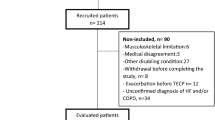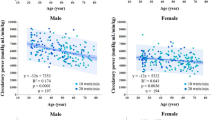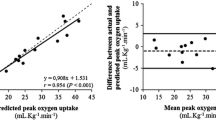Abstract
The ventilatory efficiency for carbon dioxide output (\({\dot{\text{V}}}\)CO2) during exercise, as measured by the minute ventilation vs. \({\dot{\text{V}}}\)CO2 slope (\({\dot{\text{V}}}\)E vs. \({\dot{\text{V}}}\)CO2 slope), is a powerful prognostic index in patients with chronic heart failure (CHF). This measurement is higher in women than in men, and it increases with age. This study aimed to investigate the usefulness of the predicted value of the percentage \({\dot{\text{V}}}\)E vs. \({\dot{\text{V}}}\)CO2 slope (%\({\dot{\text{V}}}\)E vs. \({\dot{\text{V}}}\)CO2 slope) as a prognostic index in patients with CHF. A total of 320 patients with CHF and a left ventricular ejection fraction (LVEF) < 45% (male, 85.6%; mean age, 64.6 years) who underwent symptom-limited cardiopulmonary exercise tests using a cycle ergometer were included in the study. The %\({\dot{\text{V}}}\)E vs. \({\dot{\text{V}}}\)CO2 was calculated using predictive formulae based on age and sex. Cardiovascular-related death was defined as the primary endpoint. The mean follow-up duration was 7.5 ± 3.3 years. Of 101 patients who died during the study period, 75 experienced cardiovascular-related deaths. The average \({\dot{\text{V}}}\)E vs. \({\dot{\text{V}}}\)CO2 slope was 32.8 ± 8.0, and the average %\({\dot{\text{V}}}\)E vs. \({\dot{\text{V}}}\)CO2 slope was 119.6 ± 28.2%. The cumulative incidence of cardiovascular-related death after 10 years of follow-up were 44.7% (95% CI 34.4–54.6%) in patients with %\({\dot{\text{V}}}\)E vs. \({\dot{\text{V}}}\)CO2 slope > 120 and 15.0% (95% CI 9.4–21.8%) in patients with %\({\dot{\text{V}}}\)E vs. \({\dot{\text{V}}}\)CO2 slope ≤ 120. The multivariate Cox regression analysis indicated that a %\({\dot{\text{V}}}\)E vs. \({\dot{\text{V}}}\)CO2 slope > 120 was an independent predictor of cardiovascular-related death (adjusted hazard ratio, 3.24; 95% confidence interval 1.65–6.67; p < 0.01). The %\({\dot{\text{V}}}\)E vs. \({\dot{\text{V}}}\)CO2 slope can be used for risk stratification in patients with CHF and an LVEF < 45%.



Similar content being viewed by others
Data availability
Data are not publicly available due to ethical restrictions.
References
Ponikowski P, Anker SD, AlHabib KF, Cowie MR, Force TL, Hu S, Jaarsma T, Krum H, Rastogi V, Rohde LE, Samal UC, Shimokawa H, Budi Siswanto B, Sliwa K, Filippatos G (2014) Heart failure: preventing disease and death worldwide. ESC Heart Fail 1:4–25
Mancini DM, Eisen H, Kussmaul W, Mull R, Edmunds LH Jr, Wilson JR (1991) Value of peak exercise oxygen consumption for optimal timing of cardiac transplantation in ambulatory patients with heart failure. Circulation 83:778–786
Gitt AK, Wasserman K, Kilkowski C, Kleemann T, Kilkowski A, Bangert M, Schneider S, Schwarz A, Senges J (2002) Exercise anaerobic threshold and ventilatory efficiency identify heart failure patients for high risk of early death. Circulation 106:3079–3084
Paolillo S, Veglia F, Salvioni E, Corrà U, Piepoli M, Lagioia R, Limongelli G, Sinagra G, Cattadori G, Scardovi AB, Metra M, Senni M, Bonomi A, Scrutinio D, Raimondo R, Emdin M, Magrì D, Parati G, Re F, Cicoira M, Minà C, Correale M, Frigerio M, Bussotti M, Battaia E, Guazzi M, Badagliacca R, Di Lenarda A, Maggioni A, Passino C, Sciomer S, Pacileo G, Mapelli M, Vignati C, Clemenza F, Binno S, Lombardi C, Filardi PP, Agostoni P, MECKI Score Research Group (2019) Heart failure prognosis over time: how the prognostic role of oxygen consumption and ventilatory efficiency during exercise has changed in the last 20 years. Eur J Heart Fail 21:208–217
Malhotra R, Bakken K, D’Elia E, Lewis GD (2016) Cardiopulmonary exercise testing in heart failure. JACC Heart Fail 4:607–616
Stelken AM, Younis LT, Jennison SH, Miller DD, Miller LW, Shaw LJ, Kargl D, Chaitman BR (1996) Prognostic value of cardiopulmonary exercise testing using percent achieved of predicted peak oxygen uptake for patients with ischemic and dilated cardiomyopathy. J Am Coll Cardiol 27:345–352
Chua TP, Ponikowski P, Harrington D, Anker SD, Webb-Peploe K, Clark AL, Poole-Wilson PA, Coats AJ (1997) Clinical correlates and prognostic significance of the ventilatory response to exercise in chronic heart failure. J Am Coll Cardiol 29:1585–1590
Ponikowski P, Francis DP, Piepoli MF, Davies LC, Chua TP, Davos CH, Florea V, Banasiak W, Poole-Wilson PA, Coats AJ, Anker SD (2001) Enhanced ventilatory response to exercise in patients with chronic heart failure and preserved exercise tolerance: marker of abnormal cardiorespiratory reflex control and predictor of poor prognosis. Circulation 103:967–972
Nanas SN, Nanas JN, Sakellariou DCh, Dimopoulos SK, Drakos SG, Kapsimalakou SG, Mpatziou CA, Papazachou OG, Dalianis AS, Anastasiou-Nana MI, Roussos C (2006) VE/VCO2 slope is associated with abnormal resting haemodynamics and is a predictor of long-term survival in chronic heart failure. Eur J Heart Fail 8:420–427
Corrà U, Mezzani A, Bosimini E, Scapellato F, Imparato A, Giannuzzi P (2002) Ventilatory response to exercise improves risk stratification in patients with chronic heart failure and intermediate functional capacity. Am Heart J 143:418–426
Guazzi M, Reina G, Tumminello G, Guazzi MD (2005) Exercise ventilation inefficiency and cardiovascular mortality in heart failure: the critical independent prognostic value of the arterial CO2 partial pressure. Eur Heart J 26:472–480
Ashikaga K, Itoh H, Maeda T, Itoh H, Ichikawa Y, Tanaka S, Ajisaka R, Koike A, Makita S, Omiya K, Kato Y, Adachi H, Nagayama M, Tajima A, Harada N, Akashi YJ, Committee on Exercise Prescription for Patients (CEPP) Members (2021) Ventilatory efficiency during ramp exercise in relation to age and sex in a healthy Japanese population. J Cardiol 77:57–64
Kleber FX, Vietzke G, Wernecke KD, Bauer U, Opitz C, Wensel R, Sperfeld A, Gläser S (2000) Impairment of ventilatory efficiency in heart failure: prognostic impact. Circulation 101:2803–2809
Beaver WL, Wasserman K, Whipp BJ (1986) A new method for detecting anaerobic threshold by gas exchange. J Appl Physiol 60:2020–2027
Wasserman K, Whipp BJ (1975) Excercise physiology in health and disease. Am Rev Respir Dis 112:219–249
Wasserman K (1984) The anaerobic threshold measurement to evaluate exercise performance. Am Rev Respir Dis 129:S35–S40
Fine JP, Gray RJ (1999) A proportional hazards model for the subdistribution of a competing risk. J Am Stat Assoc 94:496–509
Itoh H, Ajisaka R, Koike A, Makita S, Omiya K, Kato Y, Adachi H, Nagayama M, Maeda T, Tajima A, Harada N, Taniguchi K, Committee on Exercise Prescription for Patients (CEPP) Members (2013) Heart rate and blood pressure response to ramp exercise and exercise capacity in relation to age, gender, and mode of exercise in a healthy population. J Cardiol 61:71–78
Johnson RL Jr (2000) Gas exchange efficiency in congestive heart failure. Circulation 101:2774–2776
Sharma G, Goodwin J (2006) Effect of aging on respiratory system physiology and immunology. Clin Interv Aging 1:253–260
Neder JA, Nery LE, Castelo A, Andreoni S, Lerario MC, Sachs A, Silva AC, Whipp BJ (1999) Prediction of metabolic and cardiopulmonary responses to maximum cycle ergometry: a randomised study. Eur Respir J 14:1304–1313
Caminiti G, Volterrani M, Iellamo F, Marazzi G, Massaro R, Miceli M, Mammi C, Piepoli M, Fini M, Rosano GM (2009) Effect of long-acting testosterone treatment on functional exercise capacity, skeletal muscle performance, insulin resistance, and baroreflex sensitivity in elderly patients with chronic heart failure a double-blind, placebo-controlled, randomized study. J Am Coll Cardiol 54:919–927
Cundrle I Jr, Somers VK, Singh P, Johnson BD, Scott CG, Olson LJ (2013) The relationship between leptin and ventilatory control in heart failure. J Card Fail 19:756–761
Cundrle I Jr, Somers VK, Singh P, Johnson BD, Scott CG, Olson LJ (2017) Sex differences in leptin modulate ventilation in heart failure. Heart Lung 46:187–191
Reindl I, Wernecke KD, Opitz C, Wensel R, König D, Dengler T, Schimke I, Kleber FX (1998) Impaired ventilatory efficiency in chronic heart failure: possible role of pulmonary vasoconstriction. Am Heart J 136:778–785
Lewis GD, Shah RV, Pappagianopolas PP, Systrom DM, Semigran MJ (2008) Determinants of ventilatory efficiency in heart failure: the role of right ventricular performance and pulmonary vascular tone. Circ Heart Fail 1:227–233
Kato Y, Suzuki S, Uejima T, Semba H, Nagayama O, Hayama E, Arita T, Yagi N, Kano H, Matsuno S, Otsuka T, Oikawa Y, Kunihara T, Yajima J, Yamashita T (2018) Relationship between the prognostic value of ventilatory efficiency and age in patients with heart failure. Eur J Prev Cardiol 25:731–739
Acknowledgements
The authors would like to thank all members and laboratory engineers in the rehabilitation room at the Sakakibara Heart Institute.
Funding
This research received no grant from any funding agency in the public, commercial, or not-for-profit sectors.
Author information
Authors and Affiliations
Contributions
Conceptualization: KA, HI; methodology, KA, HI; formal analysis and investigation: KA, TM, HI, ST, YI; writing—original draft preparation: KA; writing—review and editing: KA, HI, MN, YJA, MI; supervision: HI.
Corresponding author
Ethics declarations
Conflict of interest
The authors declare that there is no conflict of interest.
Ethical approval
This study was performed in accordance with the ethical principles of the Declaration of Helsinki and was approved by the Human Investigation Committee of Sakakibara Heart Institute (Study Protocol No. 16–084).
Consent to participate
We used an opt-out form to obtain informed consent by placing notices in the hospital and on its website.
Additional information
Publisher's Note
Springer Nature remains neutral with regard to jurisdictional claims in published maps and institutional affiliations.
Rights and permissions
About this article
Cite this article
Ashikaga, K., Itoh, H., Maeda, T. et al. Usefulness of the predicted percentage ventilatory efficiency for carbon dioxide output during exercise in patients with chronic heart failure. Heart Vessels 38, 56–65 (2023). https://doi.org/10.1007/s00380-022-02132-w
Received:
Accepted:
Published:
Issue Date:
DOI: https://doi.org/10.1007/s00380-022-02132-w




